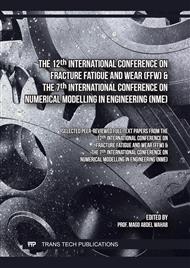p.3
p.19
p.33
p.43
p.55
p.65
p.75
p.89
Evolution Mechanism of Three-Point Bending Impact Fatigue Damage in Ultra-High Strength Steel 23Co14Ni12Cr3MoE Material
Abstract:
Carrier-based aircraft takeoff and landing devices endure repeated high-speed, high-energy, and high-load impacts during operation. This repeated impact results in fatigue damage, a primary cause of failure in these devices, commonly known as impact fatigue. To address multiple impact fatigue failures in the takeoff and landing process of carrier-based aircraft, an investigation into the three-point bending impact fatigue characteristics of ultra-high-strength steel 23Co14Ni12Cr3MoE (abbreviated as A100 material) was conducted using experimental and microscopic techniques. A reproducible impact loading device for three-point bending tests was devised, leveraging a drop hammer impact tester. This innovative setup enabled the proposal of a three-point bending impact fatigue testing method. Test specimens featuring U-shaped, V-90°, and V-60° notches were designed, drawing inspiration from the Charpy pendulum impact test for metallic materials (GB/T 229-2007). Impact fatigue testing was then performed on the drop hammer tester across five distinct energy levels: 25J, 30J, 35J, 40J, and 45J.The study comprehensively examined the load response, energy absorption, and fatigue life of the A100 material in relation to the number of notches and impacts. Post-experiment analysis using a light microscope and SEM electron microscope revealed key morphological features of the A100 material's impact fatigue fracture surface: the crack initiation zone, stable crack propagation zone, rapid crack propagation zone, and shear lip area. Notably, as impact energy rose, the crack propagation zone expanded, while the shear lip area contracted.These findings contribute significantly to understanding the fatigue behavior of A100 material under repeated impact conditions, critical for enhancing the durability and safety of carrier-based aircraft takeoff and landing devices.
Info:
Periodical:
Pages:
33-42
Citation:
Online since:
January 2025
Authors:
Price:
Сopyright:
© 2025 Trans Tech Publications Ltd. All Rights Reserved
Share:
Citation:


